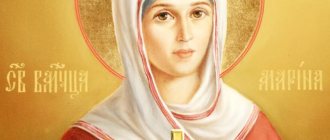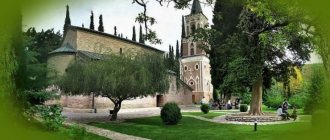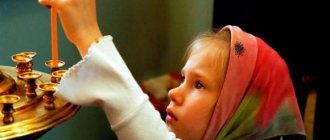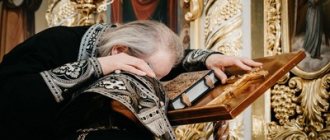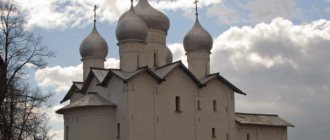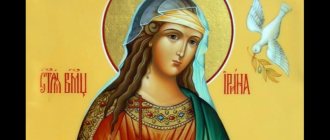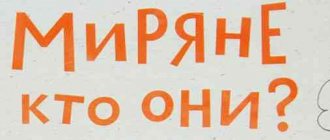When praying in front of an icon, it is very important to know the history of the saint to whom it is addressed. The history of the icon of St. Marina is full of hardships and torment.
This story began in the city of Antioch in the family of a pagan priest. Soon after birth, the girl was left without a mother; she was raised by a wet nurse outside the city, where Marina’s father sent her. At the end of the 3rd century AD. e. Fierce persecution of Christians began, which is why the latter had to hide in the forests and constantly roam. It was then, from refugees, that the little girl learned about Christianity and decided, at all costs, to be baptized. There were no temples yet, and Marina was just waiting. At the age of 15, the young girl spoke publicly about her faith. Having learned about this, the father disowned his daughter, depriving her of his inheritance.
Some time later, Marina was seen by a prefect heading into the city. He liked the beauty and ordered her to be brought to the palace. Presenting herself before the ruler, the girl honestly admitted her faith, for which she was arrested. Christianity was strictly persecuted by law, people were tortured, tortured and executed. This fate did not spare the girl either. Her body was tormented and torn. On the day of her execution, Marina was first set on fire with torches, doused with gasoline, and then thrown into the water. Standing in the fire, the girl prayed to the Lord. Water became her Baptism. A dove appeared, flew up to the girl with a branch of a vine, and Marina emerged from the water without a single trace of torture or burns, the bonds that bound her body fell apart on their own. After this, the girl was beheaded, by order of the indignant ruler.
It is believed that the Christian Theotim was present at the execution, and then stole her body and buried her with honors. The relics of the saint have been preserved and are located, divided, in many parts of the world. Just like the icons of Marina of Antioch.
Characteristics of a woman
Find out what awaits you today - Horoscope for today for all zodiac signs
Due to numerous requests from subscribers, we have prepared an accurate horoscope application for mobile phones. Forecasts will arrive for your zodiac sign every morning - it's impossible to miss! Download for free: Daily Horoscope 2020 (available on Android)
Just as an ocean wave is unpredictable, a girl named Marina can be gentle, tremulous, and can show her strength in an instant. Pride and arrogance are often inherent. He always gives account of his words, never throws them to the wind. At a more mature age, she is relaxed and smart. Seeks attention from others. An active social circle consists of a few trusted friends. If someone helps her, she will remember this all her life and will repay kindness for kindness.
A hardworking woman, she cannot imagine herself being idle. He approaches his duties responsibly. He loves activities outside of his main profession, to which he even devotes his free time. Often achieves good results. Her professionalism is appreciated by her superiors and colleagues. They consult her and set her as an example for others.
She marries a guy well known to her, often a classmate or fellow student. He must be of a calm disposition and moderately reasonable. He doesn’t cheat on his spouse, he demands the same from his other half. Does not allow conflicts in the family. If he doesn’t like something in the actions of his household, he tries to explain it peacefully. A person has a bright destiny, but the best qualities cannot always be seen the first time.
The older Marinochka is, the more charm she has. She attracts men with her charms. There is no shortage of fans. Both in marriage and in relationships, she needs constant attention, otherwise the girl will be mopey, her character will deteriorate, and she will be in a depressed mood.
Description of the icon of Saint Margaret
Very often this icon can be found under a different name: the icon of Margaret of Antioch. This name appeared only in the Middle Ages, after the division of the church into Orthodoxy and Catholicism. In the West, Marina began to be called Margarita. Her relics and icons are also kept in Catholic churches.
You should not assume that only Catholics call Saint Margaret. The aforementioned Theotimus, describing the life of Marina, called her Margarita, which means “pearl.”
Very often on icons the Great Martyr Marina is depicted with a serpent or devil
This is due to the fact that one day, after another torment, when the girl was in prison, an earthquake began, and a snake crawled out of the ground into the cell. The girl began to pray, asking the Lord for help, then the snake turned into a terrible black dog, which Marina killed, blessed by the mercy of God. Immediately a dove appeared on the window, telling the exhausted girl that she would soon be near the Lord.
They pray to the Orthodox icon of St. Margaret for protection from evil, healing from illnesses and help in childbirth. Prayer gives forgiveness to those who repent, and consolation to those who suffer. They turn to the saint for help in childbirth, protection of children, and preservation of crops. In Russia, particles of the relics of the great martyr are kept in the Holy Trinity Lavra of Sergius, in the Moscow Church of the Resurrection of Christ (Sokolniki) in a casket brought from the Holy Mountain in 1863 by the elder hieromonk Arseny.
Saints - patrons of Marina
According to some sources and the church calendar, there are two holy women with this name. More about them below.
Marina Beriyskaya (Macedonian)
Day of Remembrance:
13.03.
According to the Orthodox canon, name days take place on the day of veneration of the virgin from Macedonia. There lived a righteous woman at the turn of the century (4-5 AD). For the sake of the Lord, the girl renounced worldly life, abandoned all joys, and decided to remain chaste and meek until the end of her days. She strove for spiritual achievements in prayers and glorifications of God.
As soon as the girl turned 18, she left her home, deciding to lead a reclusive life. Together with his like-minded sister, settling outside the city limits in a wretched dugout (cave), they lived for about half a century. The food served was bread and water. 28.02. Angel Day is celebrated in memory of the Venerable Recluse Virgin of Beria according to the old style.
Saints Marina Margaret and Marina Marana.
Life of the Holy Great Martyr Marina - excerpt from Wikipedia:
Marina was born into the family of a pagan priest named Edessius from the city of Antioch, the center of the Asia Minor province of Pisidia. She was raised by a wet nurse who lived on an estate that belonged to Marina’s mother[5], who died when Marina was still an infant. The estate was located more than 20 km[6] from the city. From the nurse[2], and/or from another unnamed “man of God”[1][5] from the many wandering preachers, Marina learned the basics of Christianity.
Having heard at the age of 12 the story of the immaculate conception and birth of Jesus, Marina finally strengthened her faith in the Christian God and her intention to renounce worldly temptations. Marina decided never to get married[7] and - despite the fact that she was already attracting the attention of men, to become the “bride of Christ”[3]; some directly indicate Marina’s readiness to “lay down her soul for the Lord”[2].
Marina was executed at the age of 15[4]. Hagiographers of the Coptic Orthodox Church claim that her father had died by this time[3][8]. There are significant discrepancies between the other lives regarding the reaction of the pagan father to the Christianization of his daughter and his plans regarding the future fate of Marina. Opinions are often opposite: some lives claim that the father renounced Marina as a daughter as soon as he learned about her conversion to Christianity[2][9], while others say that, on the contrary, it was the providence of the Lord that the father did not make any attempts turn her away from the path to Christianity[10].
At the same time, still others[7] write about Marina’s normal relationship with her father, in which he was only looking for an opportunity to marry Marina to the strongest government official in the province, and still others[11] write that her father died, but Marina continued to live with her nanny. Finally, sometimes they simply state that the girl was freed from her father’s guardianship[5], but continued to live, apparently, on the same estate where she grew up: at a fatal moment for her, Marina “one day went out into the field to look at her father’s sheep, which were there grazed”[1] - alone or, in the Coptic version, with maids[8].
Two options are given for the name of the person with whom Marina could theoretically marry (hagiography options: by the will of her father or by the will of the groom), who then literally gave her up to be torn to pieces and, in the end, ordered her to be beheaded. According to Coptic sources (back translated into English) this is Lopharius Ebrotus [8]. In Western European bibliology of the 20th century (see the list of sources H. Delehaye, GH Gerould, FM Mack) he is called Olybrius [12]; here we will follow the Greek and Russian [5] writing traditions based on it - Olymbrios .
The position of Olymbrius is eparch[1][5], or prefect[10], or “ruler” (English governor)[3] or imperial ruler in English. ImperialGovernor[7] provinces.
Olimvriy drew attention to Marina at the moment when she was outside the city, grazing her father’s sheep, and Olimvriy himself was returning to Antioch along the road that ran near the field. Sometimes it is specified that the ruler was returning to Antioch from the city of Asia, making, by order of Diocletian, a tour of the Pisidian region “to search for and execute Christians”[5]. At the same time, if the life does not speak of Marina’s father’s intention to marry her off, the passion that gripped the ruler at the sight of a young girl and developed to its extreme limits is emphasized (“Olimvrius looked at the girl with voluptuousness, increasingly inflamed with a carnal feeling for her”[5] ). This love motive is contrasted with the steadfastness of faith and convictions of the young Christian woman - the bride of Christ.
Faith helps Marina overcome the lightest, everyday level of temptations. Already at the first approach of the soldiers sent by the ruler, she offers a prayer:
Lord Jesus Christ, my God! Don't leave me and don't let my soul perish! May my enemies not overcome me, may my hearing not be defiled by their crafty speeches, may my mind not yield to their nasty temptations, may my heart not be afraid of their terrible threats. Do not allow my faith to be cast into dirt and mire, so that the devil, who hates good, will not rejoice, but send me help from the height of Your Throne, give me wisdom, so that I may be strengthened by Your power and answer the questions of the tormentor without fear. Yes, my Lord, look mercifully on me at this hour; behold, I am now like a sheep among wolves, like a bird among fowlers, like a fish in a net; come and deliver me from the wiles of the enemy![5]
And although in the subsequent direct conversation with Olimvriy, Marina bluntly stated that she believed in Christ, that she was united with heartfelt love only with him and did not want another groom, Olimvriy took her with him to Antioch. There, according to some lives, a stronger temptation awaited her - a demonstration of power and wealth: upon arrival in the city, Olimvrius “entrusted Marina to noble women”[1]. But neither their possible admonishing speeches addressed to her (“why does this girl, left without a mother, not want to live with me in luxury?” [7] asked Olimvriy), nor, finally, the third, strongest temptation that awaited Marina the next day - when Olimvriy proposed his hand and heart to her publicly, in the city center, from the podium of the prefect [5] - Marina remained unshakable in her refusal.
The triad of everyday temptations is immediately replaced by physical suffering, also divided into three stages, each of which increases in strength. At all these three stages of the temptation to end the pain at the cost of apostasy, the martyr again draws strength to overcome physical suffering in her prayers to the Lord. But even this, the second level of temptation, does not exhaust the content of the saint’s feat. The source of the third level of testing is Satan himself, whose onslaught is also threefold.
The devil appears to Marina for the first time in prison, on the night after the first day of torture, when she prays, as the Coptic version specifies, with her hands folded in a cross[8]. Russian hagiography emphasizes that in this prayer Marina herself asks the Lord:
Let me see the enemy of the human race fighting against me. Let him stand face to face with me. You are the Judge and Ruler of the living and the dead - so judge between me and the devil. Deliver me from destruction. Help me defeat him. With your invincible power and send Satan to the underworld[5].
Taking the form of a serpent (dragon), Satan devours the captive. Marina manages to create a prayer and the sign of the cross in his womb, which tears the one who absorbs her into pieces[3]. Once again finding herself on the floor in the dungeon, Marina notices Satan himself in the corner - Beelzebub personally[5]. Having recognized that in the form of a dragon Marina had defeated Rufus, her kinsman, the “prince of demons” proceeds to the second onslaught, physical.
A feature that distinguishes the VMC. Marina from other holy virgins and even husbands, is that to Satan - unlike people, before whom the girl is powerless - Marina offers active physical resistance[4]. She not only prays, but also attacks the devil with all available means - and victory is on her side. Having entered into physical combat with Beelzebub, Marina continues to say prayers, and suddenly notices a copper hammer lying in the corner of the dungeon. Having grabbed it, she begins to hit Satan on the head with it, holding him by the hair (or horns). Stepping on Satan’s neck, Marina said: “Get away from me, lawless father of Gehenna!” After this, the heavens opened, the body of the martyr received healing from yesterday’s wounds; a voice from above encouraged her not to be afraid of anything, calling: “And now, Marina, study the thoughts of Satan, test his heart and bind him forever.”
The conversation that Beelzebub enters into with the girl represents the third onslaught of Satan. Here, under the guise of frankness in the story about his atrocities, he again tries to entice her into the sins that the young girl is resisting - “the father of lies Beelzebub decided, as always and everyone, to deceive the saint”[5]. His speeches are filled with details close to naturalism about exactly what shameful vices he inclines people and, in particular, young virgins. Boasting that even the strongest cannot resist his cunning (“I make even the saints doubt, I change their minds, I confuse their hearts, and at night, during sleep, I put desires in them”), Beelzebub continues
I put a burning fire of passion into their hearts, and sin becomes a sharp sword that wounds souls. I mock every person mired in debauchery, darkening his mind, making him proud and arrogant. I try to catch all people in my nets, but especially those like you - immaculate and pure virgins... I attack virgins and figure out how to drag them into the abyss of apostasy and destruction with the passion of fornication[5].
But here too Marina defeats the devil. “Be quiet,” she answered the demon, “I won’t let you lie and say unnecessary things.” It was useful to learn about the secrets that you unwittingly revealed to me in your “confession.” But out of your devilish arrogance, you began to boast and replace the truth you hate with fiction. You are a liar and a deceiver." After this, without waiting for an answer, the martyr dissolved the abyss with the sign of the cross, sending Beelzebub to the underworld with the parting words: “Go into the hellish abyss until the Last Judgment, until you give an answer for the souls you destroyed.”[5]
The day of the last round of torture and death of Marina (as well as 85 Christians executed at the same hours outside the city) is presented in the lives as the day of the triumph of Christianity, for these executions themselves and the circumstances surrounding them contributed to the opposite - even more massive conversion to Christianity.
The image of Malchus, a citizen of the Empire who converts to Christianity, forced to carry out Marina’s death sentence, is contrasted with the image of the prefect Olimbrius, a Roman who, despite his personal sympathy for Marina, is obliged to torture and execute her. Being present at the torture, Olimvriy psychologically cannot overcome the suffering he sees; he covers his face with his hands[1] or a cloak[5]. Malchus, a Christian himself, on the way to the place of execution confesses to Marina that he perceives his duty as the destiny of the Lord[5]. However, all lives testify: when the moment comes to cut off Marina’s head, he, Malchus, turns out to be psychologically unable to carry it out. Only after Marina herself warns him: “If you don’t do it, you won’t be with me in the Kingdom of Heaven,” he cuts off her head and immediately ends his life by throwing himself on the same sword.
…………….
The differences between Eastern and Western Christianity, which culminated in the adoption in the Catholic tradition of the new name of the Great Martyr from Antioch - Margaret - have a long history. A number of Western European secular bibliological monographs (whose opinion is reflected in the Dictionary of Saints) state that already in 494 Pope Gelasius I declared her life apocryphal. The same sources claim that her ancient liturgical cult did not exist[12], and that her first hagiographic mention dates back to the 9th century (martyrology of Rhabanus Maurus).
For their part, Eastern Christian Lives do not mention the actions of Gelasius; They call the saint herself, as the inscriptions on the icons say, with only one name - Marina. In relation to St. VMC. Marina is given another series of events there. This is the transfer of part of her relics by the Greek Empress Maria, wife of Leo III the Isaurian in the 8th century to Constantinople. There they were kept in the monastery of Christ the All-Seer until 1204, when the city was taken by the crusaders. This is the transfer of another part of her relics in 908 from Antioch to Italy, where they were placed in Monte Fiascone, in Tuscany. This is, finally, a silver reliquary casket with a holy brush and the inscription in Greek “relics of St. Marina,” he was seen back in the 17th century in Venice, in the temple named after her[5].
It has been suggested that at some stage in the history of Western Europe, Marina was renamed Margarita in Latin hagiography as a reverse translation of the nickname “pearl”, given to her for her beauty and nobility[5]. Despite the similarity of her life story, from a certain point the saint began to be venerated in different parts of Europe under different names: closer to the south and east under the original name Marina, and in the West and North - as Margarita. Schism, i.e. The division of Christians into Orthodox and Catholics further strengthens the divide, and until the end of the 20th century, the Western name Margaret was not recognized by Orthodoxy, and those named by it at birth received baptism in the name of St. VMC. Marina. In the world of non-Orthodox Europe, the name Marina (translated as “sea”) is traditionally popular in Mediterranean Italy and Slavic Poland (for example, Marina Mniszech).
Cult veneration of the military service. Marina is developed in countries geographically closest to the saint’s homeland (now it is one of the southern vilayets of Turkey) - Orthodox in Greece and Bulgaria, as well as in the Coptic Orthodox Church in Egypt. Particles of her relics are found in large quantities on Mount Athos. Part of the saint’s hand is in Xenophon, the left arm with the hand is in the Iveron Monastery, the leg is in the Philotheus Monastery, and one of the ribs is in the Russian Panteleimon Monastery. Large parts of the relics of St. Marinas are kept in Hilandar and Esphigmen. In Italy the relics of the military center. The Marinas, taken from Constantinople by John de Borea (and who saved him from a storm on his way to Venice), were placed in the Church of St. Liberal, later renamed in her honor, from where in the 19th century they were transferred to the Church of St. Thomas in the same city[5].
Description of the icon of Marina of Beria
Marina Beriyskaya also lived until the middle of the first millennium. The great martyr spent her entire adult life serving the Lord and instructing others on the path of faith. The saint lived in solitude and endured hunger: Marina ate once every 40 days. Sometimes the icon of Marina of Beria can be found with the name of Macedon.
Travelers turn to the icon of Marina Beria, to whom she gives strength and protection on a dangerous path. The saint’s prayer will strengthen one’s faith and help one to endure hardships steadfastly and patiently.
Special prayer:
Your Lamb, Jesus, Marina calls with a great voice: I love You, my Bridegroom, and, seeking You, I suffer, and I am crucified and buried in Your Baptism, and I suffer for Your sake, for I reign in You, and I die for You, that I may live with You, but accept me as an immaculate sacrifice, sacrificed to You with love. Through prayers, as the Merciful, save our souls.
The main proof of the gospel gospel is the feat of martyrdom, which has become a central phenomenon in the Christian world. It is difficult for an Orthodox Christian to imagine how one can endure as much torment as was suffered and endured by the holy martyrs. Such a feat was possible only thanks to complete surrender to the will of the Lord and the help of God's grace. Among the works of ancient icon painting, not the least important is the ancient icon of the Holy Great Martyr Marina of Antioch.
The icon of Saint Marina the Great Martyr is very popular among women with this wonderful name. Today, many icon paintings dedicated to this wondrous image can be purchased in special departments at churches or in an Orthodox online store, as well as ordered from an icon painting workshop. Images of St. Marina on icons embroidered with beads are very popular. A beautiful image in rich clothes, skillfully decorated with precious materials and jewelry additions, a skillfully selected combination of colors and shades of beads, the personal holy icon of Marin is a real example of the highest icon-painting skill.



